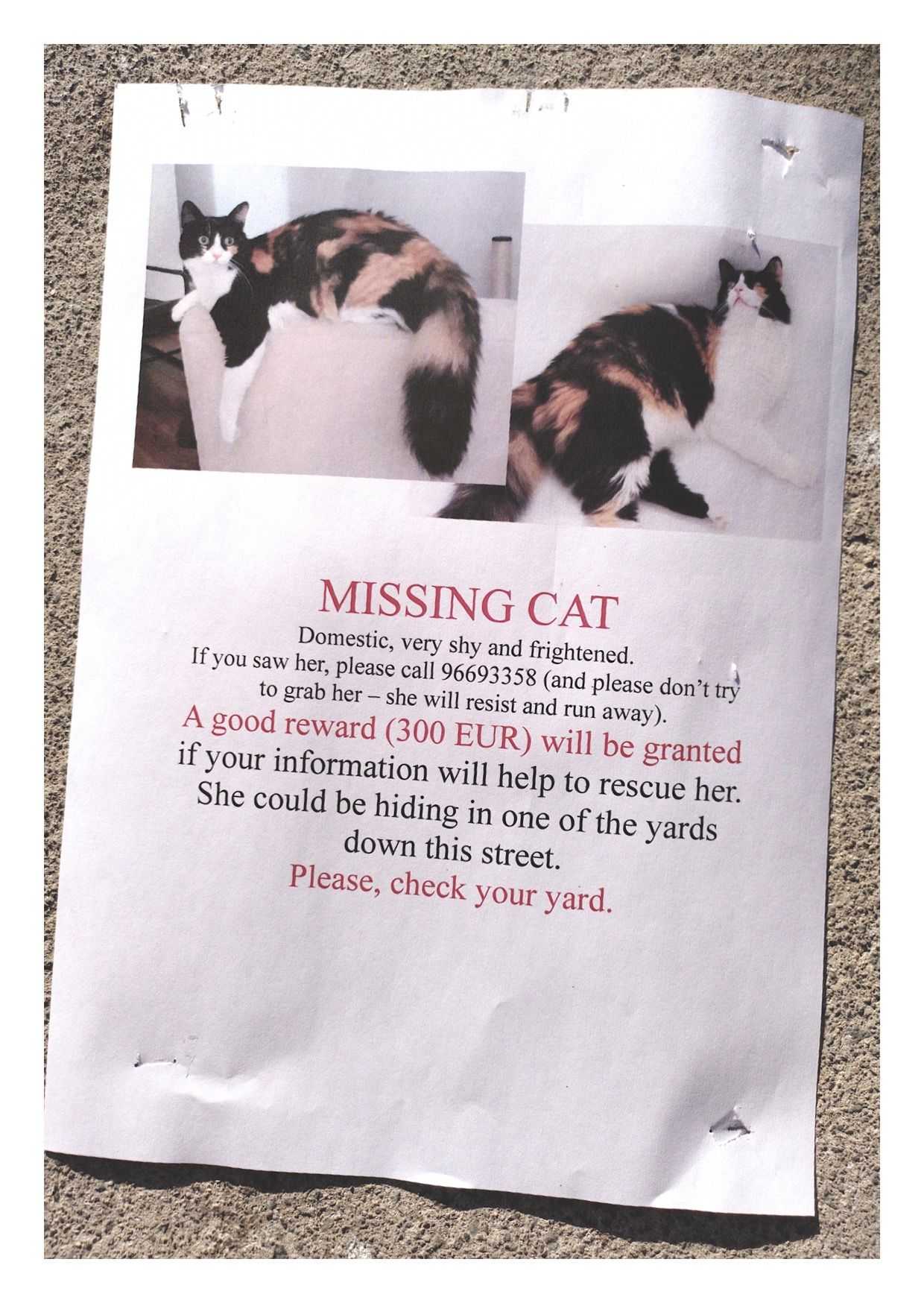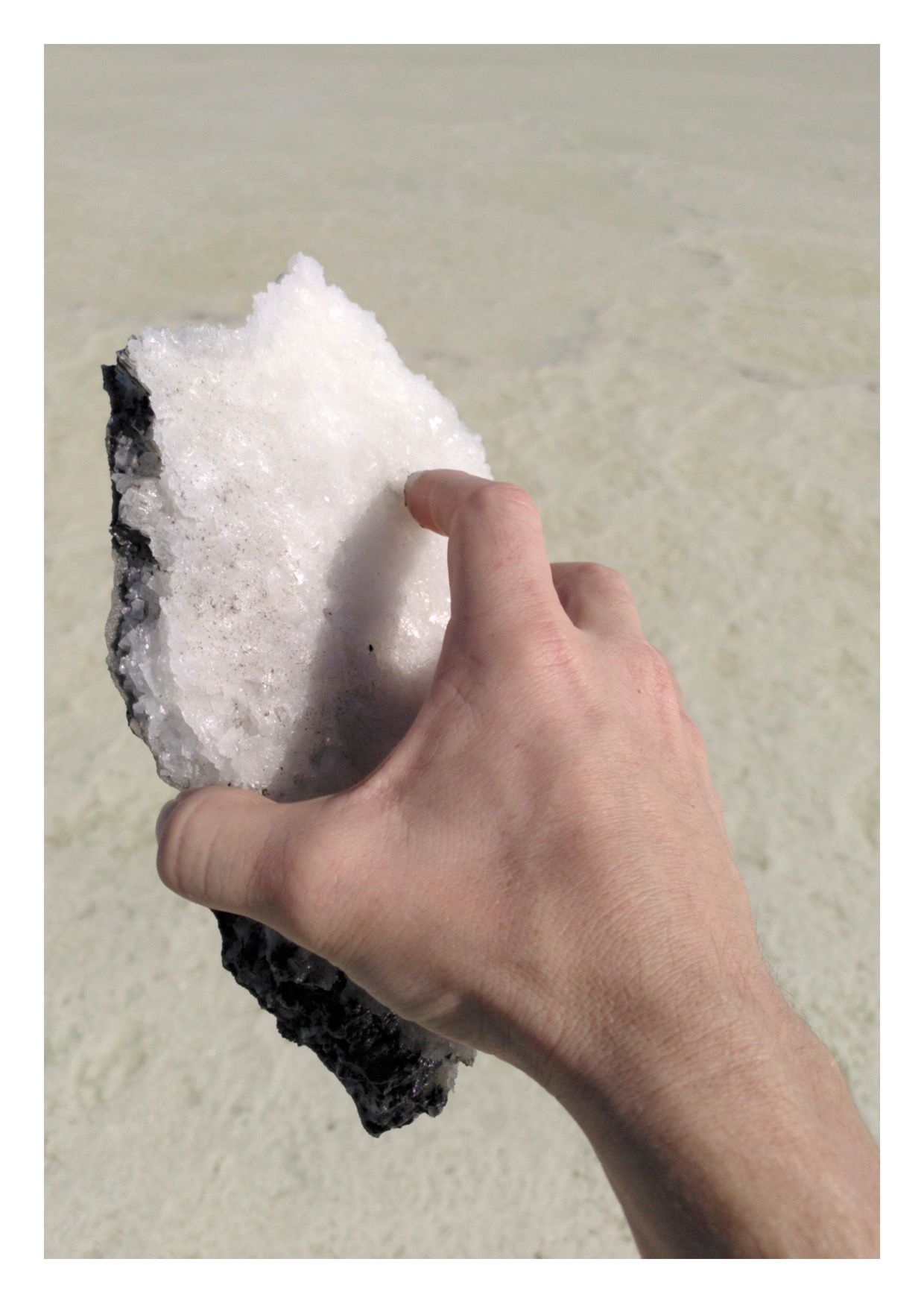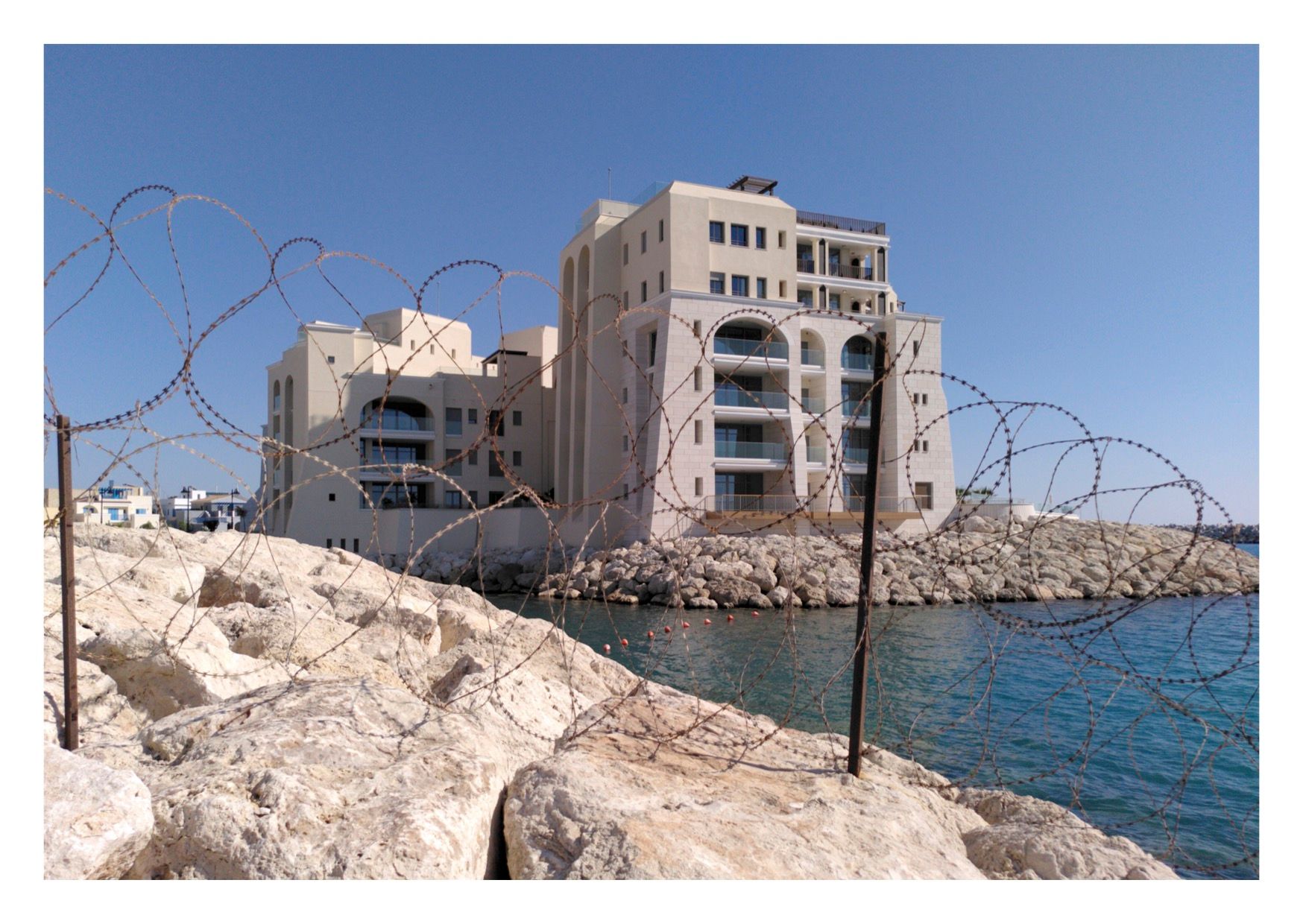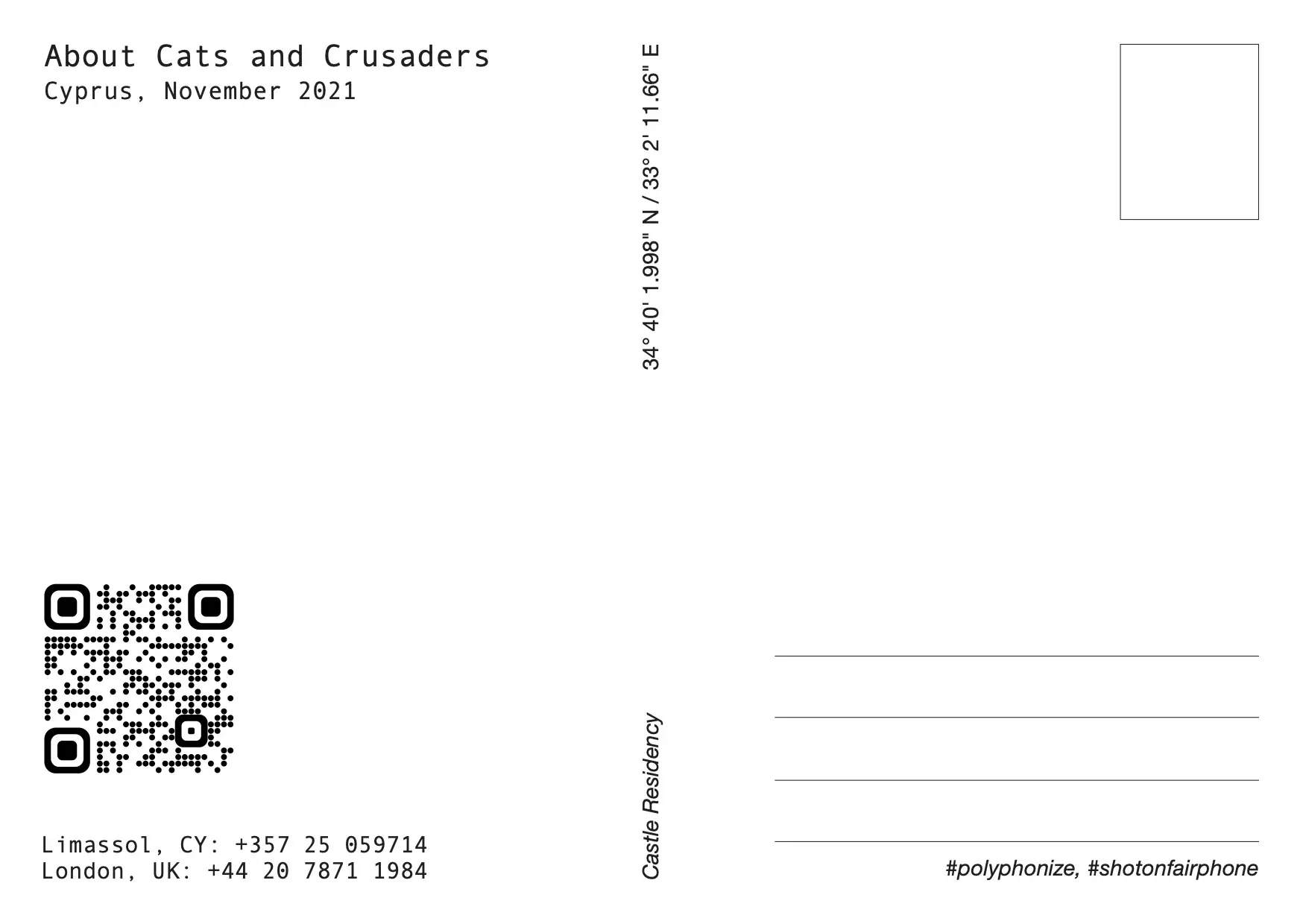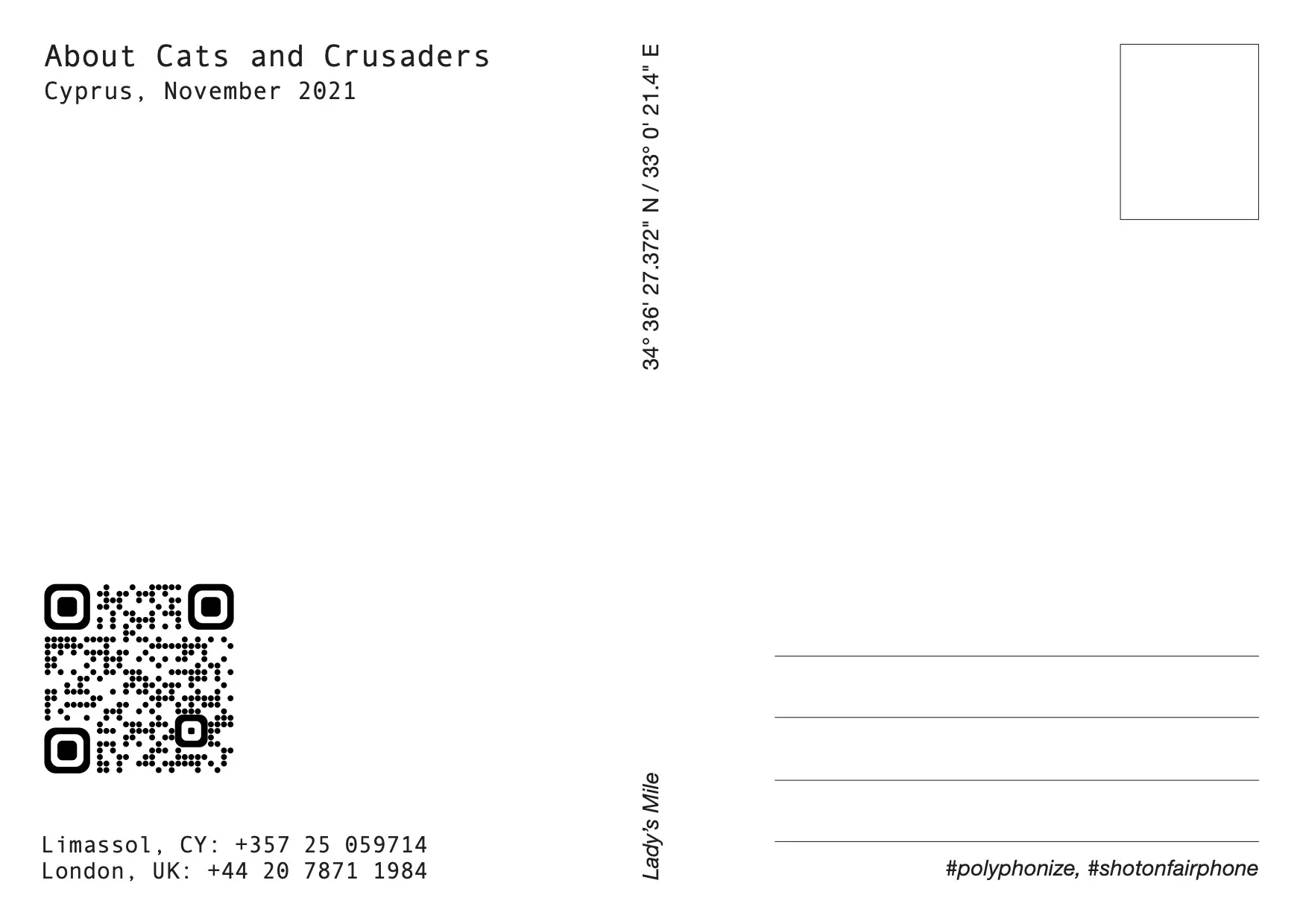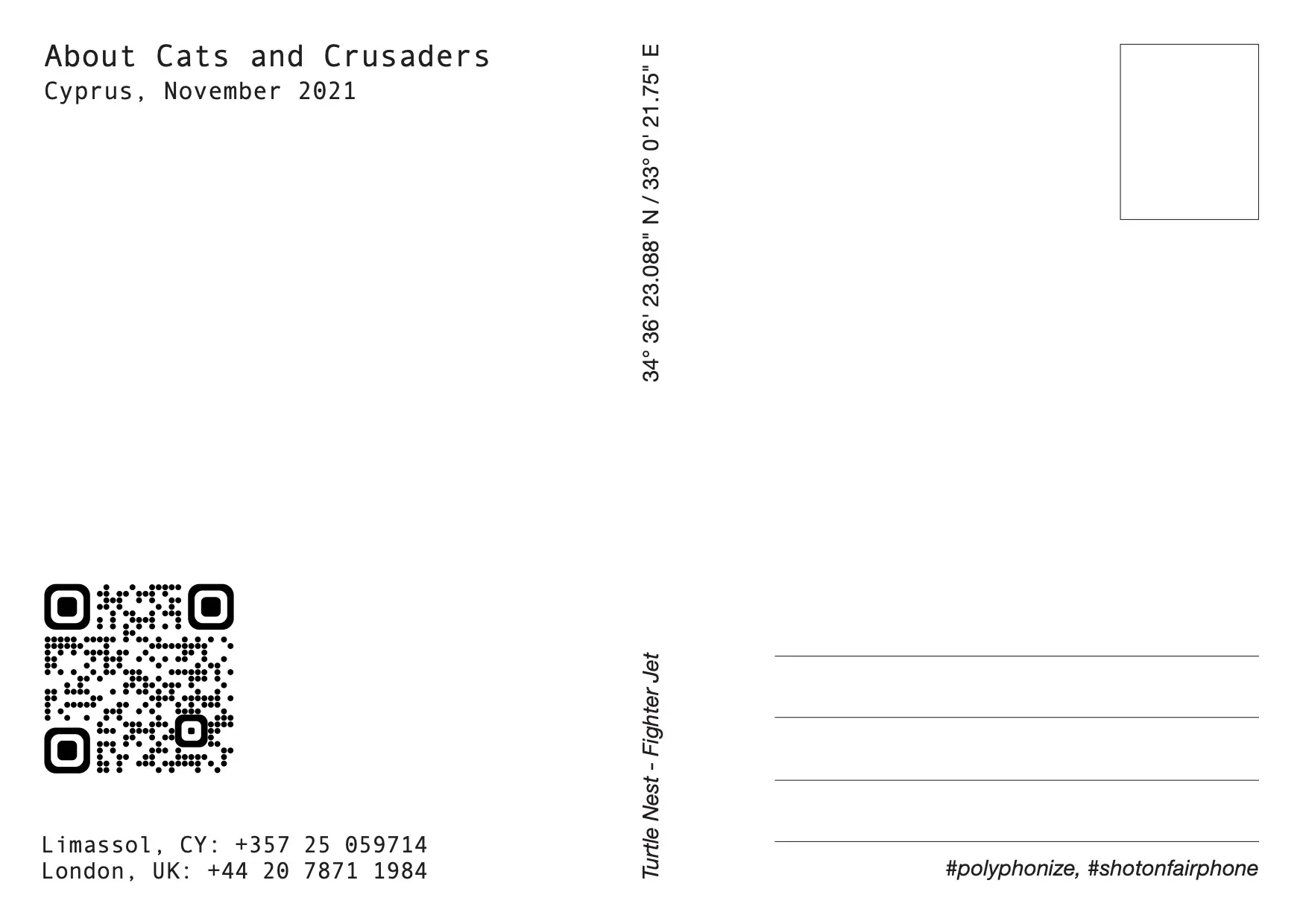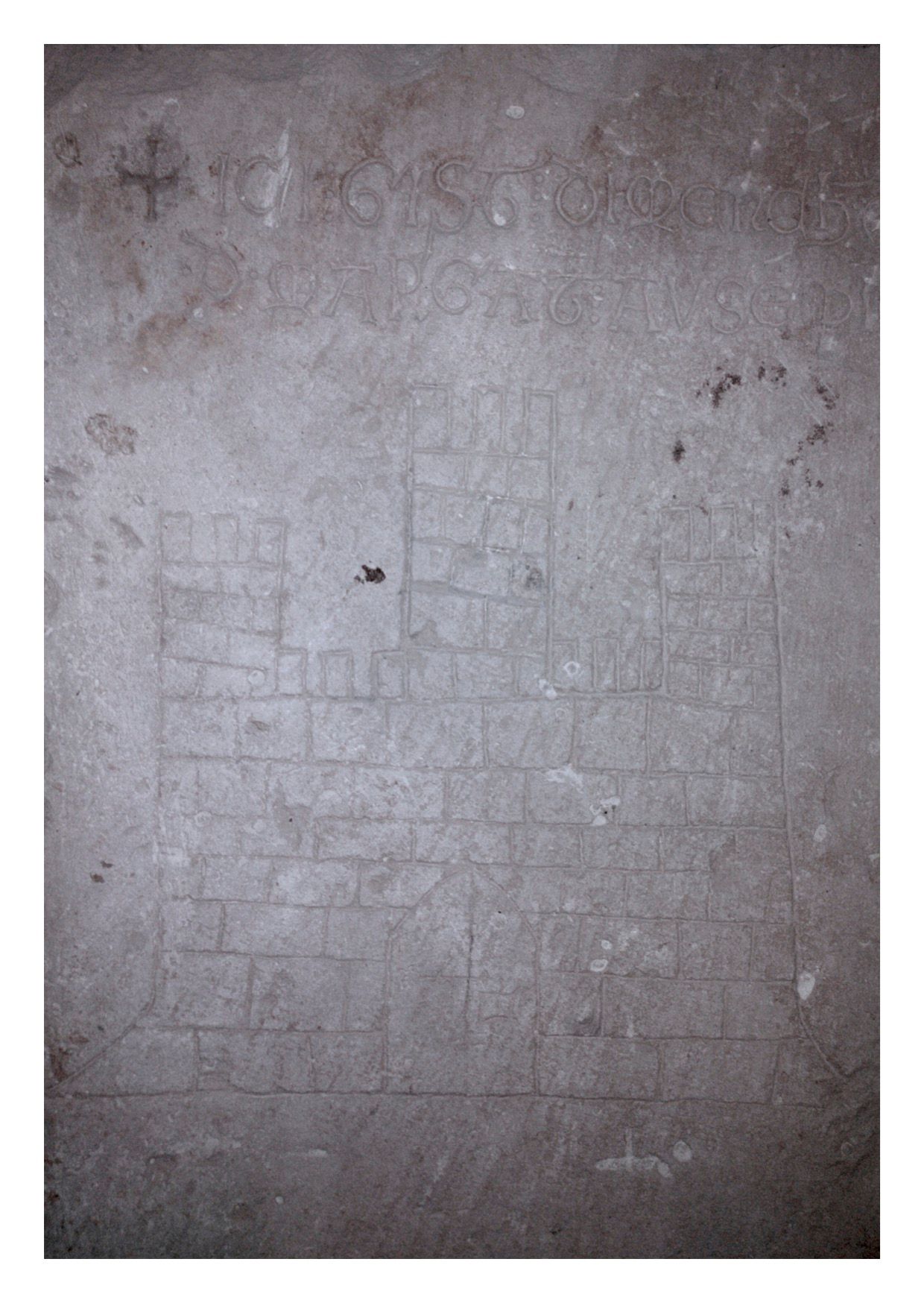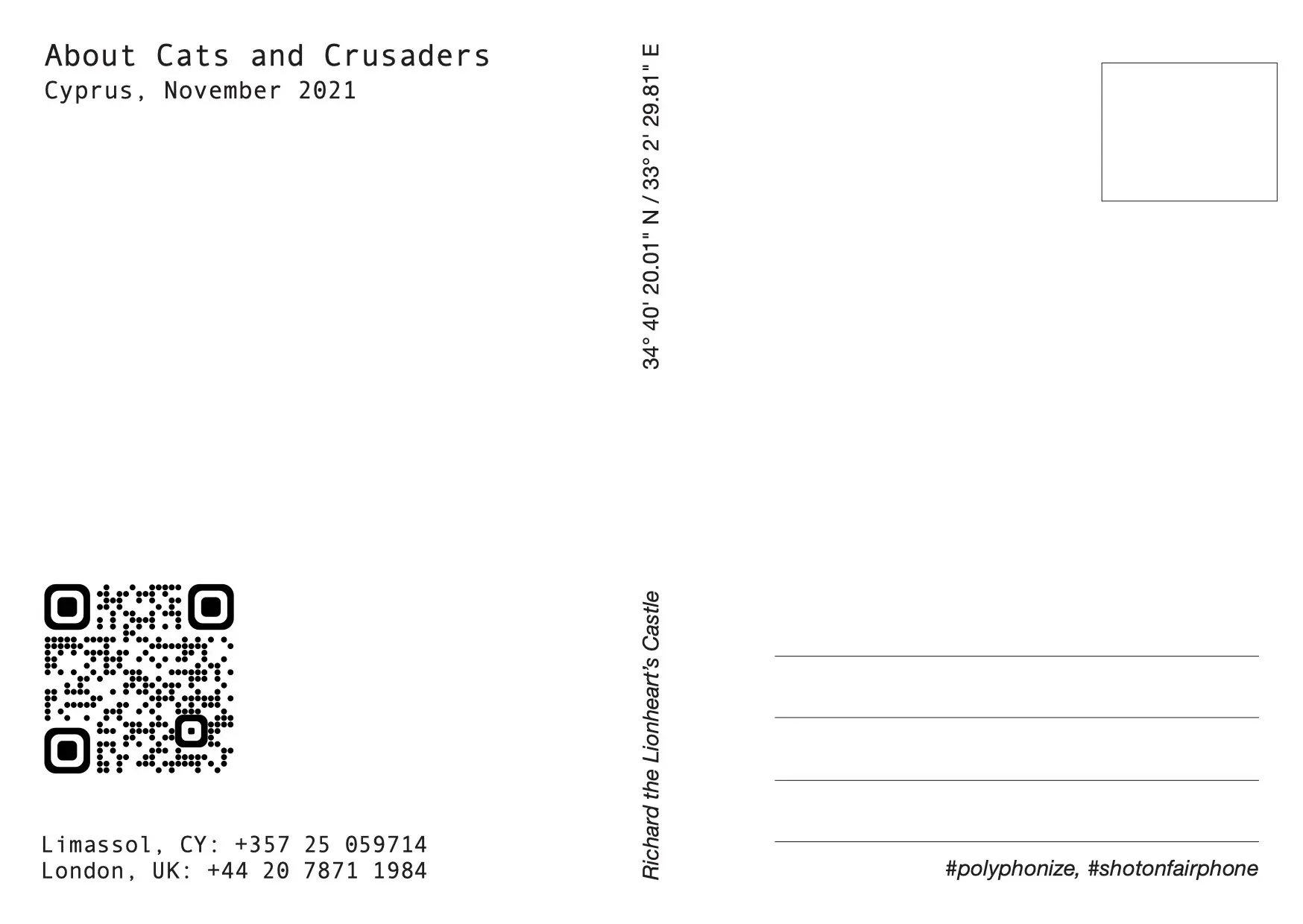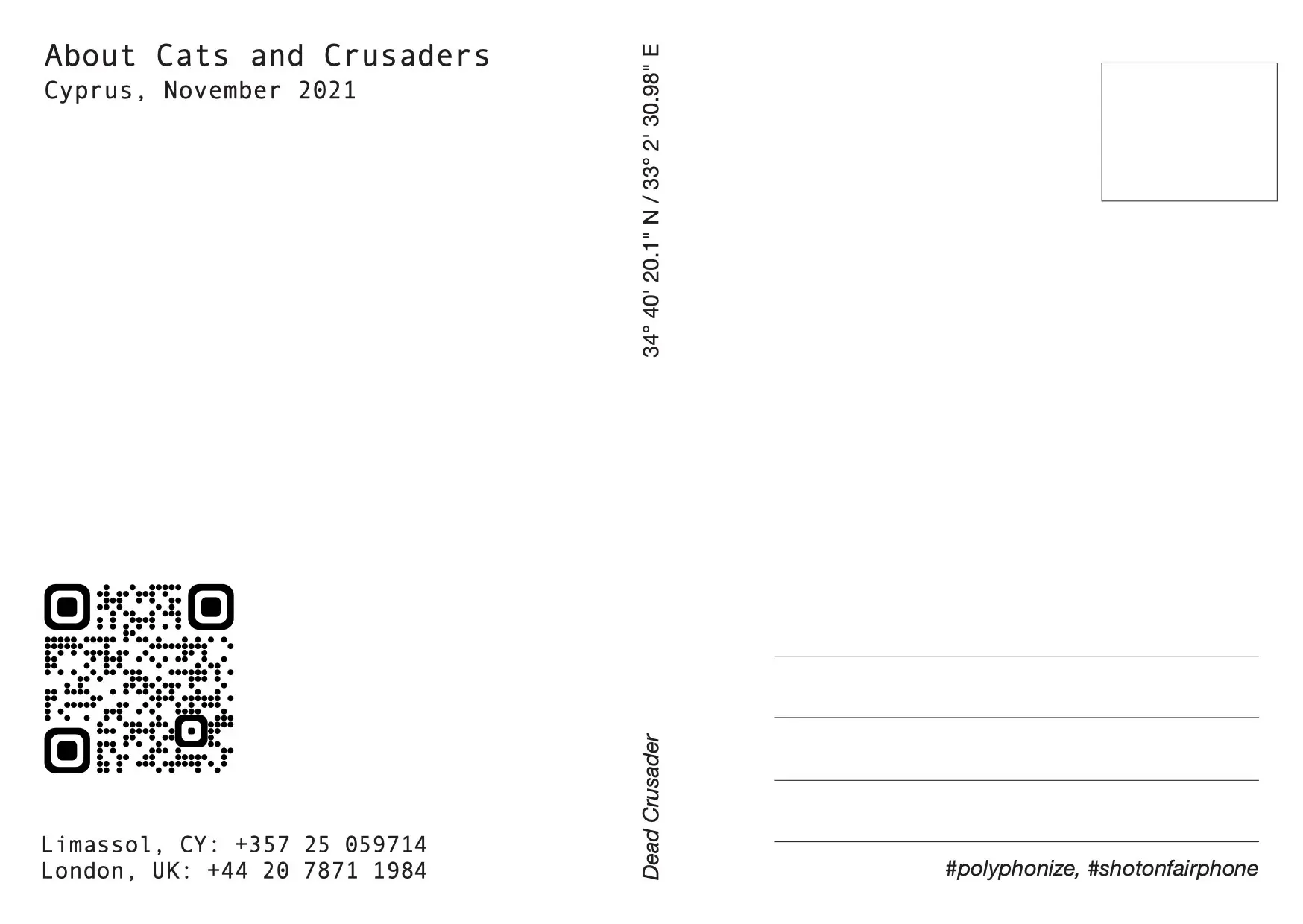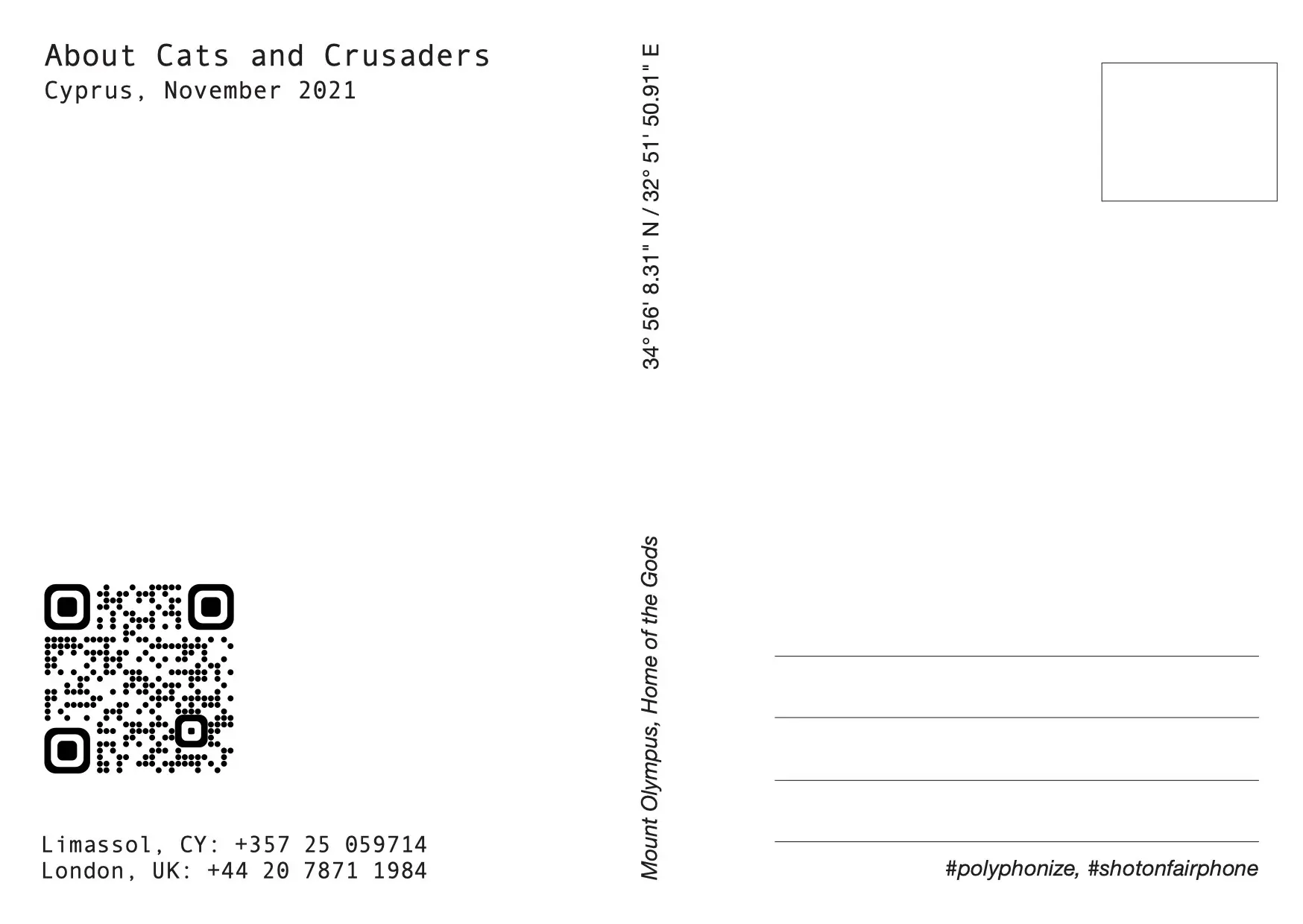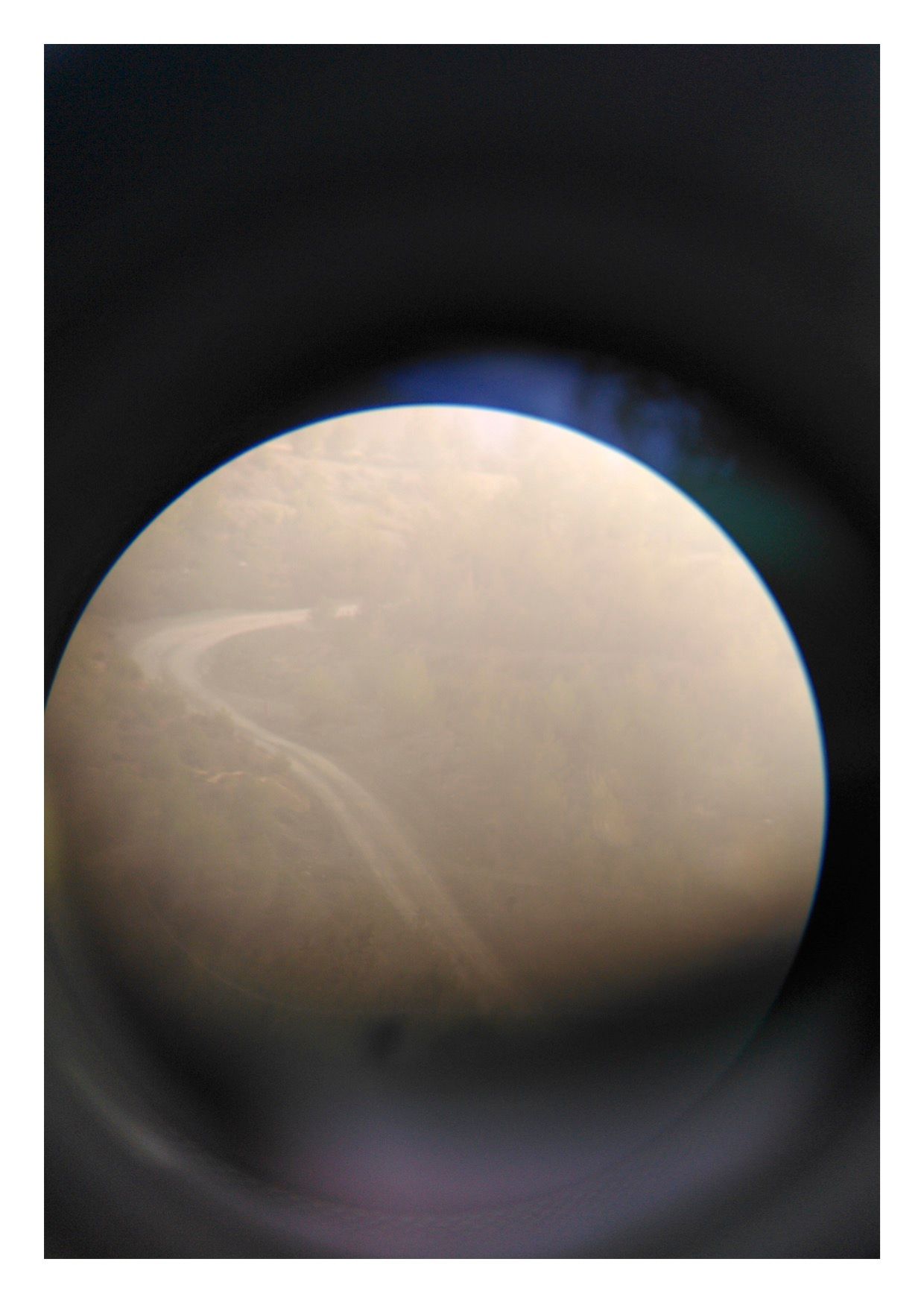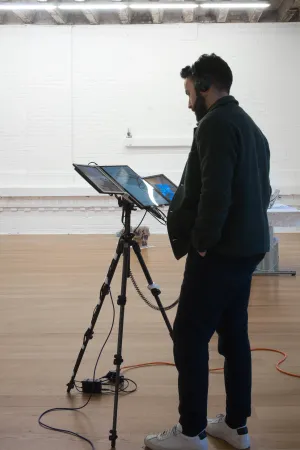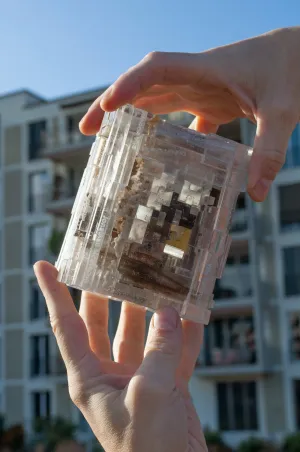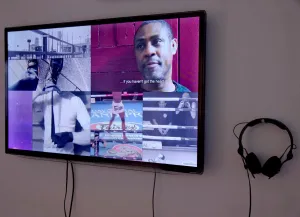
About Cats and Crusaders
"I always find it problematic to create a new piece of work in response to a place that I have never been to, especially when I can only spend a very short period of time at that place. I have never been to Cyprus before - so the Polyphonize Project falls into this category. The main challenge I see is this question: how can I have a meaningful dialogue through my work, that does the place (in this case Cyprus), its culture and its people justice?
This is the reason why I decided to spend the time I had on Cyprus in November 2021, by simply being 'there'. I wanted to see as much as possible, I wanted to gather experiences with fellow artists and friends and I wanted to talk to people - without the pressure of having to produce something right away. Still, I decided to come up with an idea while I was there and to do something later, in response to my experience.
*
Cats and crusaders are two entities that repeatedly appeared in my dreams during my stay on Cyprus. Cats are kind of obvious, because they are everywhere. Crusaders on the other hand, even though less obvious, repeatedly entered my thoughts as well, perhaps because I visited Richard the Lionheart's castle in Limassol, maybe because of the British military presence on the island. For some reason the helicopters racing up and down Lady's Mile Beach between Akrotiri Military Base and Limassol reminded me of the old Christian knights, riding their horses on the very same beach toward the castle in old Lemessos.
This is why I started to write down my thoughts About Cats and Crusaders. These short texts literally talk about cats and about crusaders within the context of Cyprus. At the same time they open up broader questions about power, geopolitics, strategy and living together. If you want to experience this audio piece call either of these phone numbers:
Once you call one of these numbers, you will be presented with different recordings. These spoken texts provide food for thought and the framework for a possible dialogue. After all, there is the option to talk to my directly.
If I have time, I will pick up. Otherwise you can leave a message on my voicemail.
I might call you back."
Limassol, November 2021

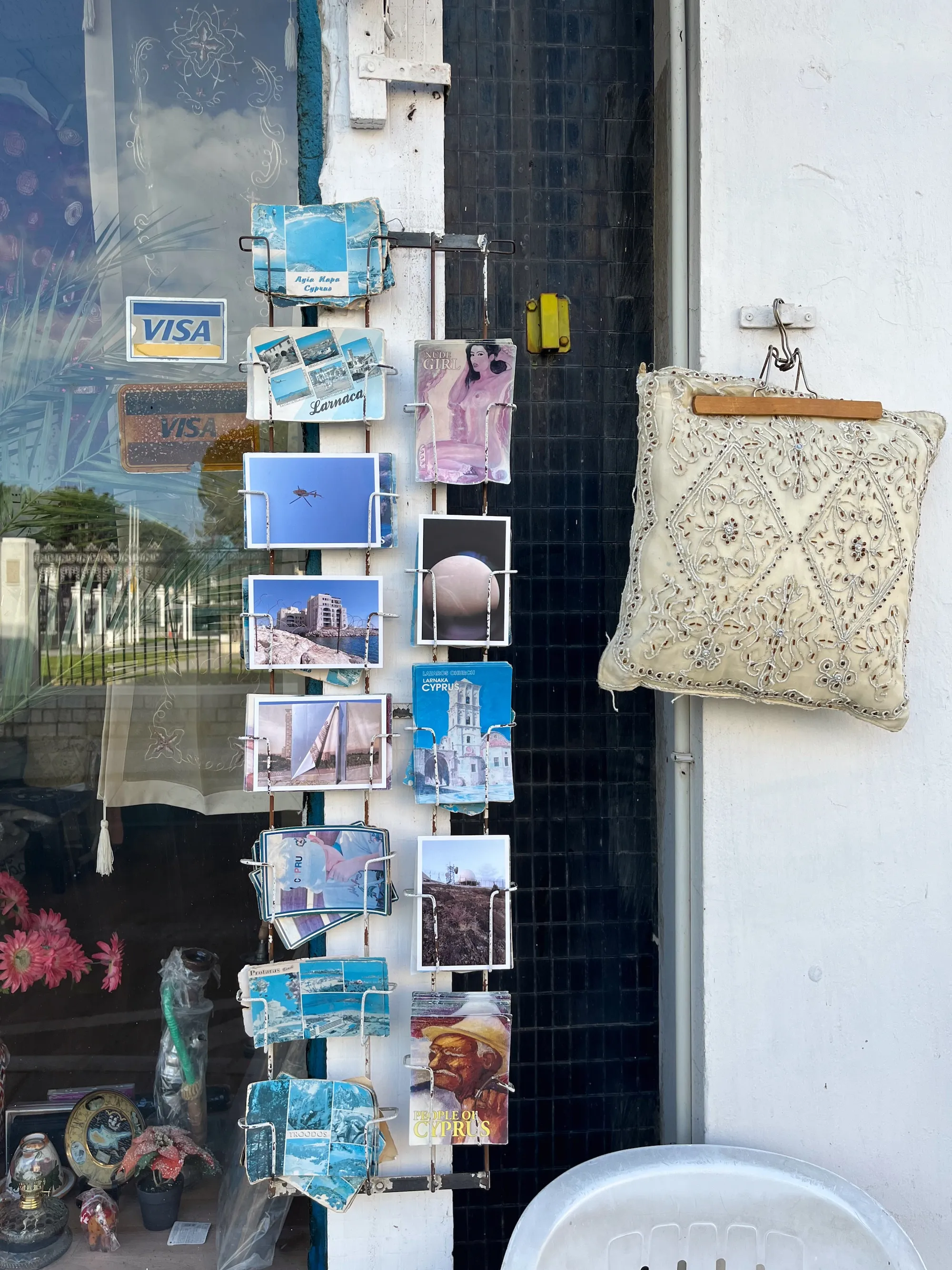

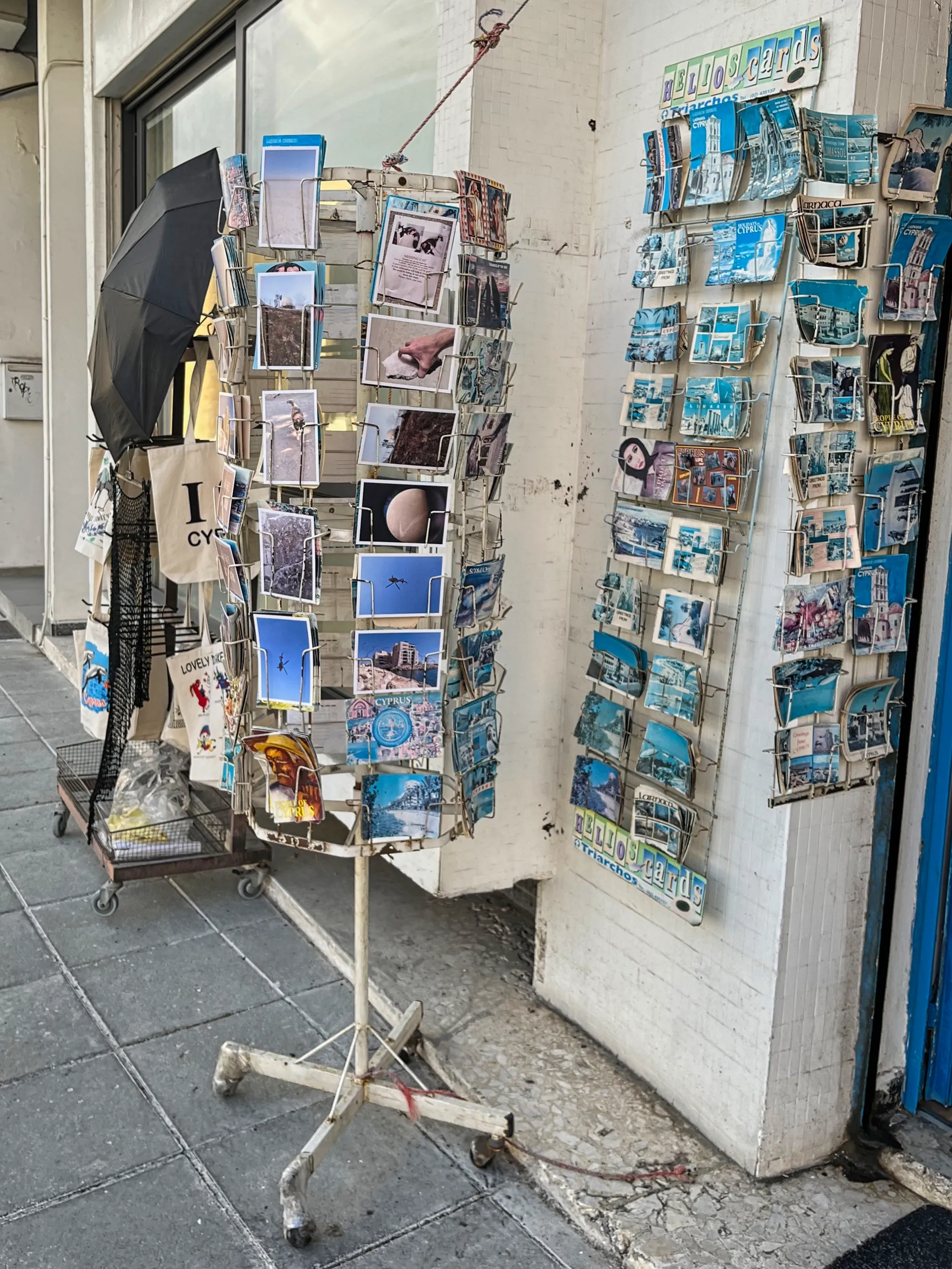

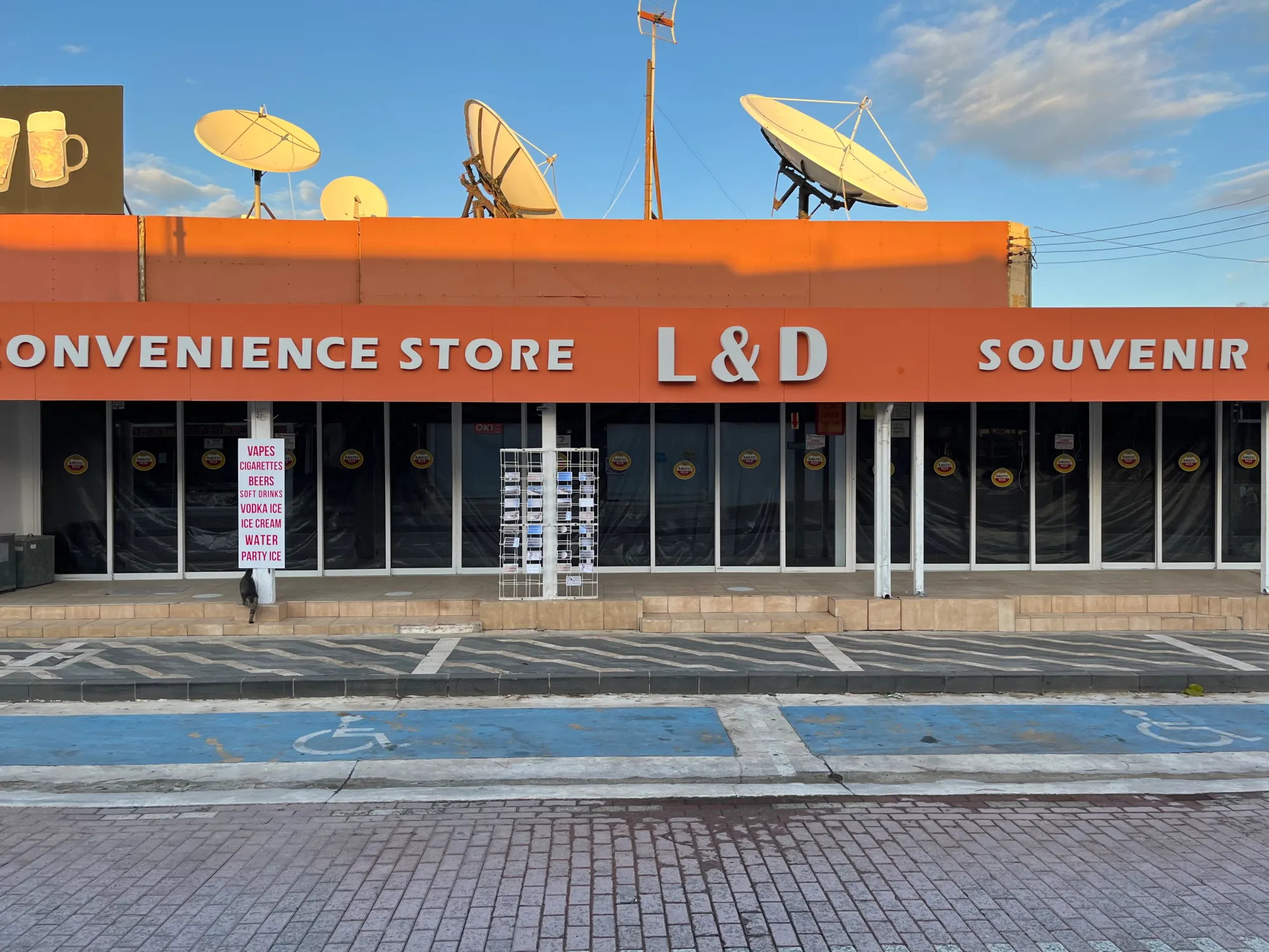
Photographs by Ilina Chervonnaya, Nov-Dec 2022, Cyprus
+357 25 059714, +44 20 7871 1984
To experience the piece, call one of these numbers!
-> intro
Hey, my name is Daniel.
Last year I visited Cyprus for the first time in my life. I mainly stayed in Limassol. Immediately I noticed the cats, lots of them - and British military helicopters.
There are areas that are completely off-limits for normal people. For example gated communities for the super-rich, and the UN buffer zone between Turkish Cypriot and Greek Cypriot territories.
The traces of war are still here. Yet the cats go everywhere.
There also is an old castle in Limassol, that for some time was used by Richard the Lionheart during the 3rd crusade in his quest to conquer Jerusalem, as well as the Holy Monastery of St. Nicolas of the Cats, right next to Akrotiri Military Base - on British sovereign territory.
Cyprus has always been an important strategic place in the Mediterranean Sea.
Nothing has changed about that.
* * *
If you want to hear more about Cats, press [1]
If you want to hear more about Crusaders, press [2]
[1] -> cats
According to legend, in the first century before Christ, thousands of cats were brought to Cyprus by Cleopatra, queen of Egypt, to combat a plague of snakes on the island. The snakes were thriving because of a major drought, which lasted for more than forty years. The Christian version of the same story claims that it was Saint Helena in the year 326, who brought the cats to Cyprus instead.
As a result, there are now more cats on Cyprus than human beings.
But cats used to live on Cyprus long before they were sent on their crusade against the snakes. The earliest known grave of a human being, who was buried with a domesticated cat, was in fact not found in Egypt, but on Cyprus. It dates back to the Neolithic Age, long before the Pyramids were built. Did you know that the origins of todays cat, can be traced back even further? Before cats were domesticated, they lived as wild animals in old Mesopotamia, which is now known as the Middle East.
Cleopatra's cats arrived on a beach, today known as Lady's Mile, close to the location where one can now find the Holy Monastery of Saint Nicolas of the Cats, as well as the largest British Military Base on Cyprus. It is the same coast where, according to legend, Aphrodite, the goddess of love, rose out of the sea. Because of this legend there now is a breed of cats called 'Cyprus Aphrodite'.
Lady's Mile also is the very same beach, where Richard the Lionheart landed with his fleet, a few hundred years ago during the 3rd crusade. In 1191 he arrived in Limassol. Then he took Cyprus with his troops and used the island as a strategic base for his war in Arab territory. In the name of Christianity he moved his armies into the so-called 'Holy Land', to conquer Jerusalem. Even though he won many battles, he did not succeed in the end.
There are many old stories and depictions of Christian Knights fighting dragons or snakes. To me these stories and depictions, as well as the history of the crusades, bear a strange resemblance to the story of the cats that were brought to Cyprus to wage war against the snakes.
In Christian mythology snakes often symbolise evil. It is said that the snake is responsible for the first original sin, which is the reason why we are not living in the garden of Eden anymore. Yet today I wonder: Aren't only we to blame? The right conditions do exist: our planet still has enough space and resources for everyone to live a decent life. We actually could be living in Eden right now.
* * *
If you want to hear more about Crusaders, press [2]
If you want to hear a poem about 'The Cats of Saint Nicholas' by GEORGE SEFERIS, press [3]
If you want to talk to me directly - 'About Cats and Crusaders', press [7]
[2] -> crusaders
The so called ‘Holy Crusades' in the Middle Ages were not only driven by belief and religious conviction. More importantly they were about power, economics and control. On the one hand Christian countries in Europe chose to demonstrate strength toward the Muslim world and a powerful Arab Empire. On the other hand Christian kings needed to reinforce and justify their own claims to power in their home countries.
Throughout its history, Cyprus has been raided, invaded and occupied by many armies because of its strategic location in the Mediterranean Sea. Those who want to exercise control over the Mediterranean Sea need a foothold on Cyprus, which is why Richard the Lionheart first conquered Cyprus, before he continued to march against Jerusalem.
As a former British colony, Cyprus now hosts some of the most important British Military Bases abroad, still on sovereign British territory - even though the British released Cyprus into independency in the 1970-ties. There is for example Akrotiri Military base, an important hub for the Royal Air Force and Dhekelia, a British Military enclave and important listening post for the British intelligence and cybersecurity agency GCHQ. Mythical mount Olympus, the highest mountain on the island and former home of the old Gods is now occupied by new Gods: British forces maintain a radar station on its peak. Similar to Richard the Lionheart, who invaded Cyprus during the 3rd crusade on his way to conquer Jerusalem, the British military today uses the strategic location of Cyprus as a foothold in the Mediterranean Sea, - in close proximity to Syria and the rich treasures of oil in Middle East.
Starting a war still is a strategy today. It is used by powerful people to reinforce and justify their claims to power. Wars can still be a distraction from domestic problems (be it political or economic), while such problems can sometimes also be used as an excuse to start a war and also to obscure a hidden agenda. I often wonder: Are the old ‘Crusaders' who in the past went to war in the name of ‘Christianity' today replaced by simple ‘Soldiers’ who fight in the name of their ‘Nation'? Has 'Religion' as a reason to go to war, even though still not completely irrelevant, been replaced by 'Nationalism'?
According to legend, the old Knights of the Templars were searching for the 'Holy Grail’. What do you think is the equivalent of the 'Holy Grail’ today? For example, sometimes I ask myself wether a 'Golden Passport', only available to the super-rich who isolate themselves behind the walls of Gated Communities, could be viewed as something like the 'Holy Grail': an unreachable mythic object that promises salvation - or just peace and prosperity.
After all, isn't a peaceful and prosperous life all that most of us want - and that everybody deserves? Yet if peace and prosperity are destroyed in the name of 'Religion' or 'Nation', what do those terms actually mean?
* * *
If you want to hear more about Cats, press [1]
If you want to hear a poem about 'The Cats of Saint Nicholas' by GEORGE SEFERIS, press [3]
If you want to talk to me directly - 'About Cats and Crusaders', press [7]
[3] -> The Cats of Saint Nicholas
'That's the Cape of Cats ahead,' the captain said to me,
pointing through the mist to a low stretch of shore,
the beach deserted; it was Christmas day —
'. . . and there, in the distance to the west, is where
Aphrodite rose out of the waves;
they call the place "Greek's Rock."
Left ten degrees rudder!'
She had Salome's eyes, the cat I lost a year ago;
and old Ramazan, how he would look death square in the eyes,
whole days long in the snow of the East,
under the frozen sun,
days long square in the eyes: the young hearth god.
Don't stop, traveller.
'Left ten degrees rudder,' muttered the helmsman.
. . . my friend, though, might well have stopped,
now between ships,
shut up in a small house with pictures,
searching for windows behind the frames.
The ship's bell struck
like a coin from some vanished city
that brings to mind, as it falls,
alms from another time.
'It's strange,' the captain said.
'That bell — given what day it is —
reminded me of another, the monastery bell.
A monk told me the story,
a half-mad monk, a kind of dreamer.
'It was during the great drought,
forty years without rain,
the whole island devastated,
people died and snakes were born.
This cape had millions of snakes
thick as a man's legs
and full of poison.
In those days the monastery of St Nicholas
was held by the monks of St Basil,
and they couldn't work their fields,
couldn't put their flocks to pasture.
In the end they were saved by the cats they raised.
Every day at dawn a bell would strike
and an army of cats would move into battle.
They'd fight the day long,
until the bell sounded for the evening feed.
Supper done, the bell would sound again
and out they'd go to battle through the night.
They say it was a marvellous sight to see them,
some lame, some blind, others missing
a nose, an ear, their hides in shreds.
So to the sound of four bells a day
months went by, years, season after season.
Wildly obstinate, always wounded,
they annihilated the snakes but in the end disappeared;
they just couldn't take in that much poison.
Like a sunken ship
they left no trace on the surface:
not a miaow, not a bell even.
Steady as you go!
Poor devils, what could they do,
fighting like that day and night, drinking
the poisonous blood of those snakes?
Generations of poison, centuries of poison.'
'Steady as you go,' indifferently echoed the helmsman.
* * *
If you want to hear more about Cats, press [1]
If you want to hear more about Crusaders, press [2]
If you want to talk to me directly - 'About Cats and Crusaders', press [7]
-> intro -> read by Daniel Vollmond
[1] -> cats -> read by Johnny Eveson
[2] -> crusaders -> read by Johnny Eveson
tech support -> SIP trunking & VOIP server -> term7
IDENTITY \ LABOUR
May - June 2023, Salon Mondial (CH)
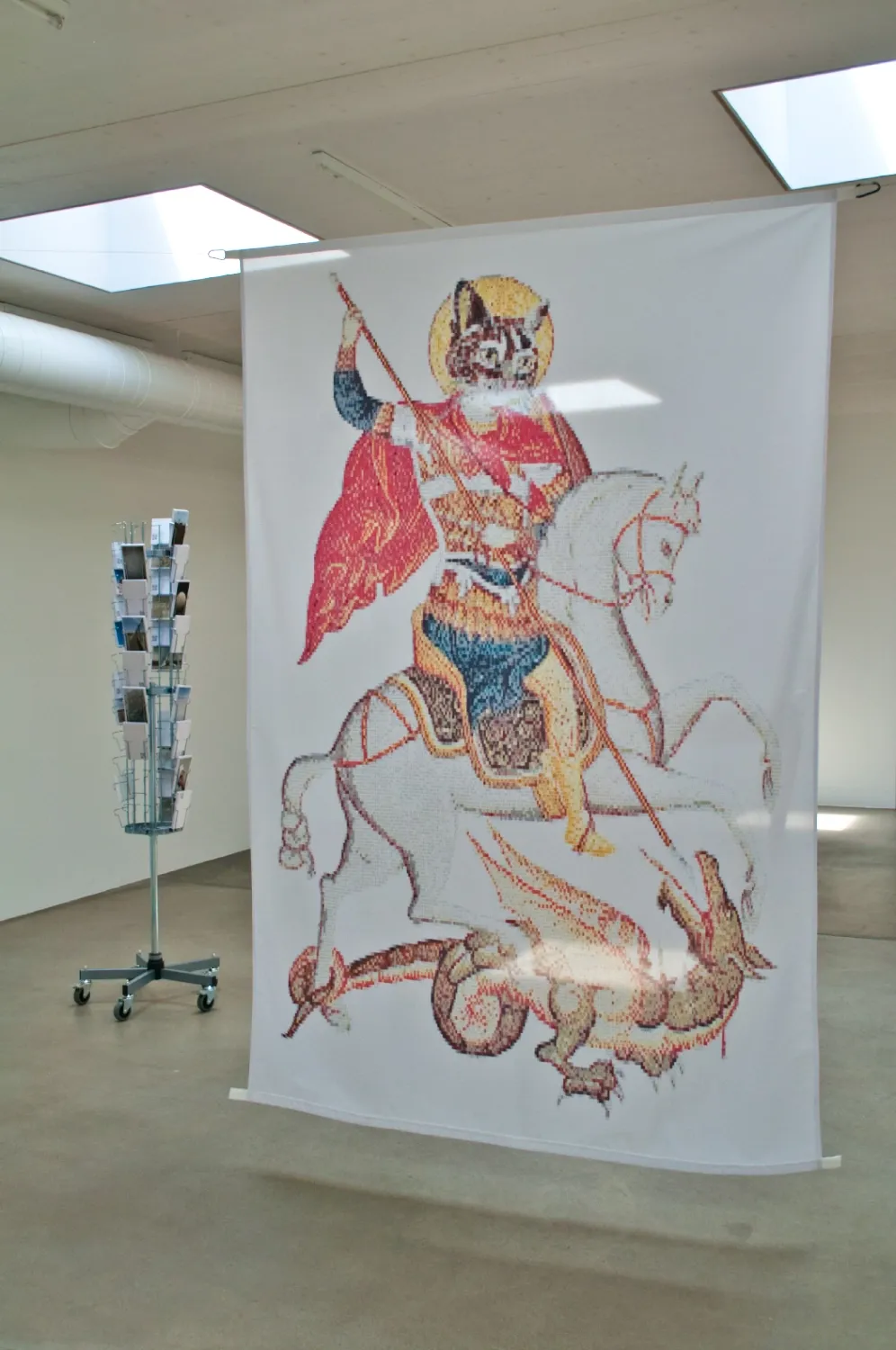


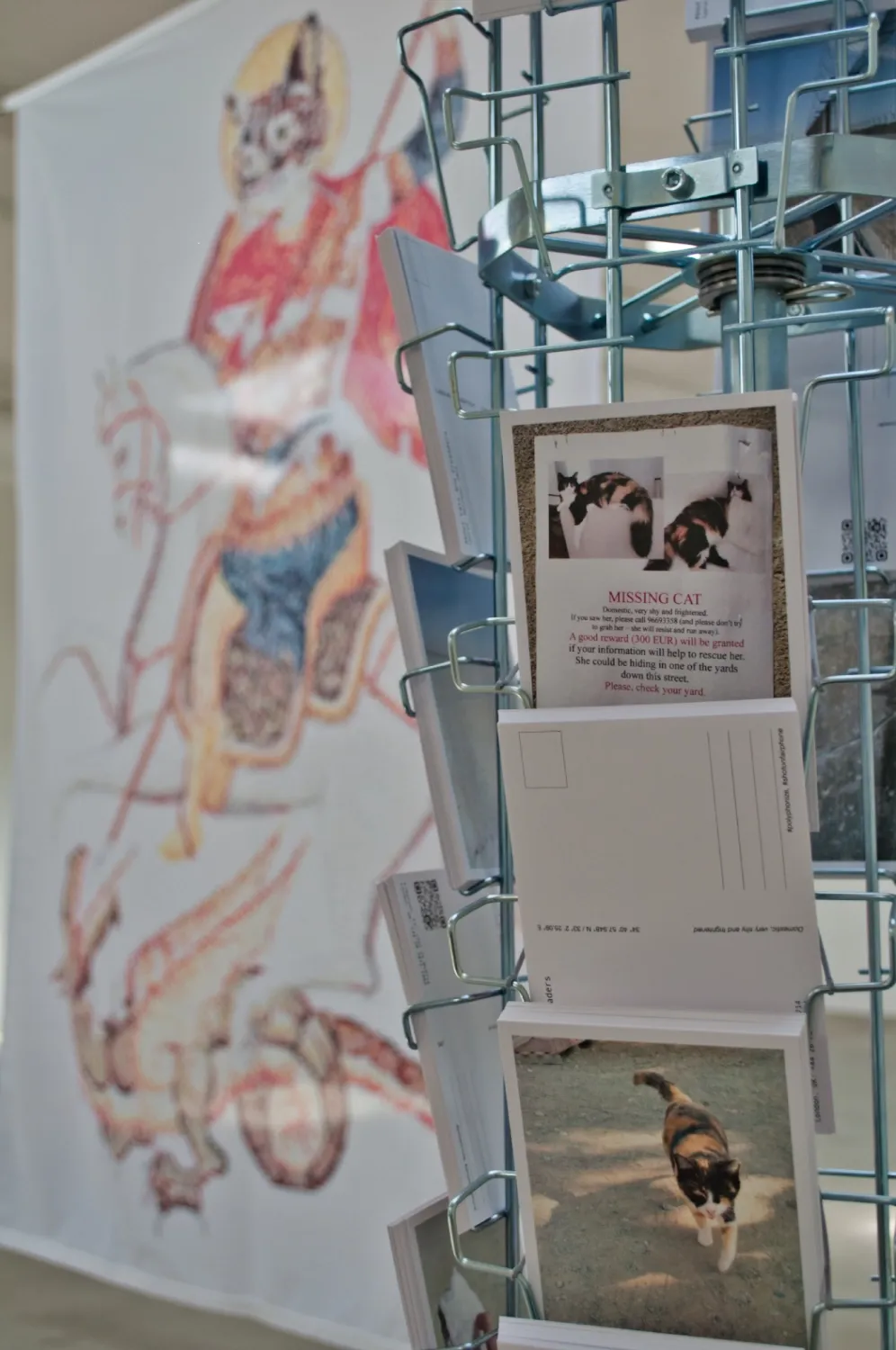
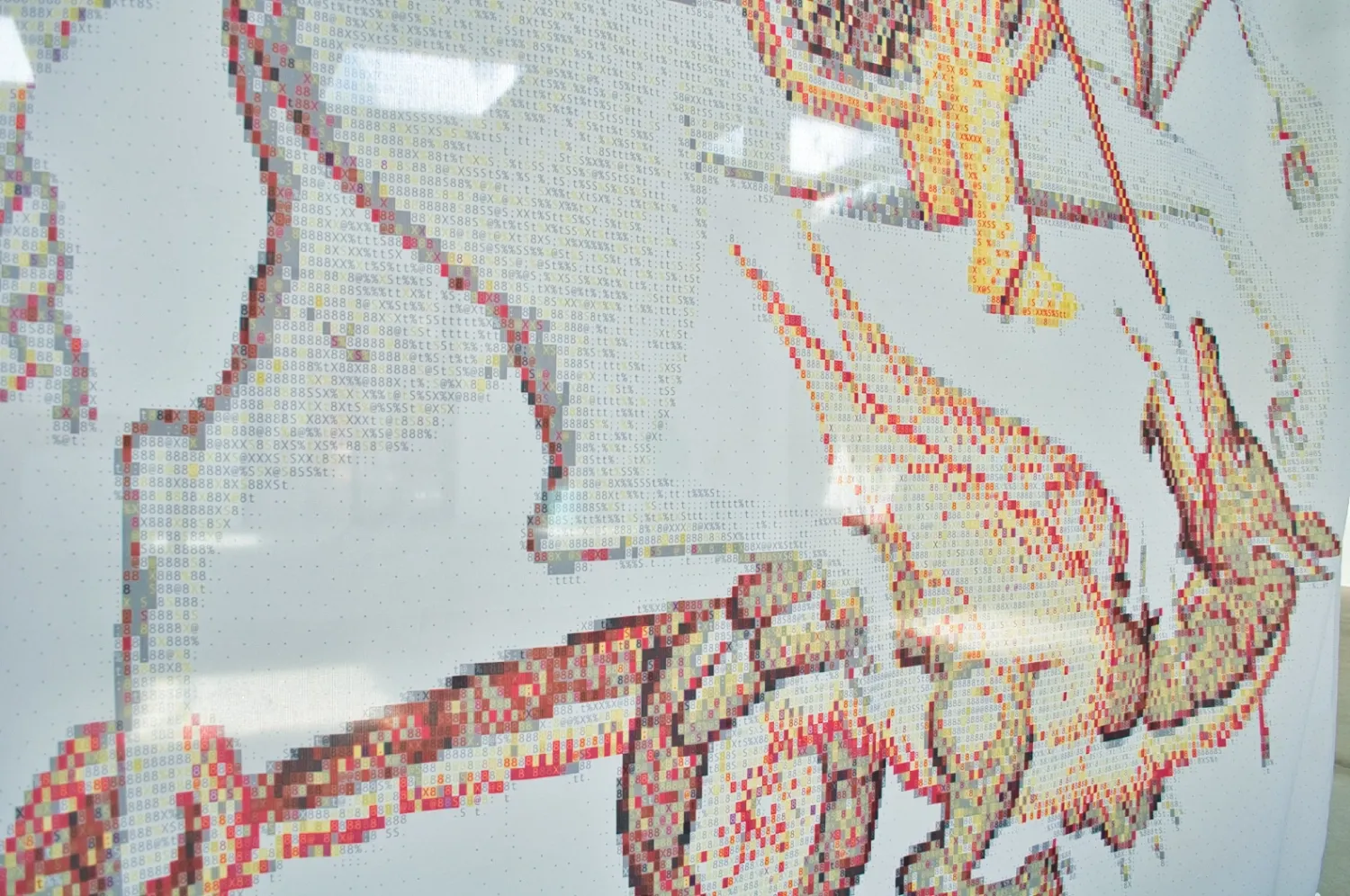
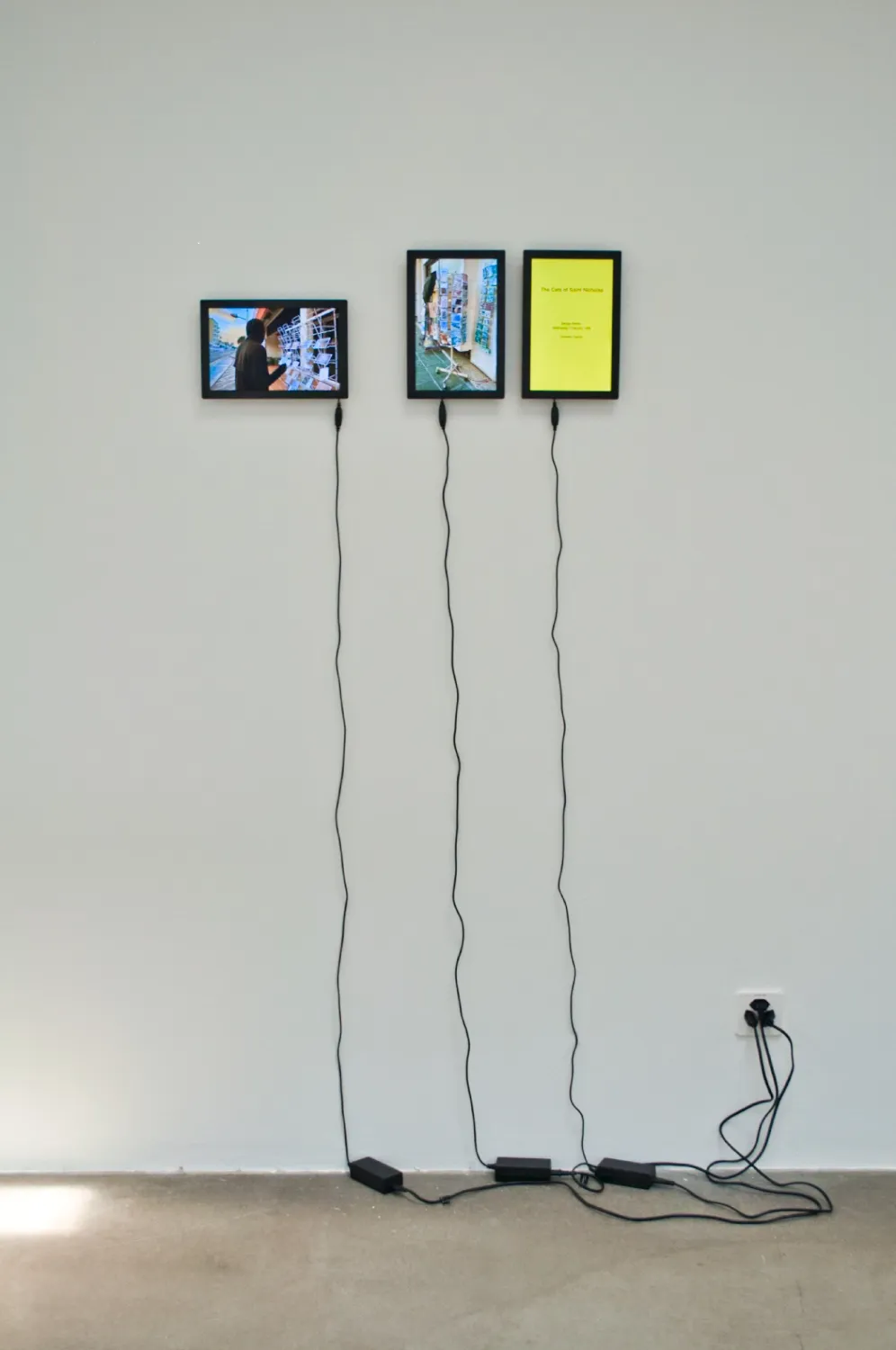

About Cats and Crusaders at Salon Mondial, Basel
Curated by Alice Wilke
An exhibition by Daniel Vollmond & Lynne Kouassi
Installation: About Cats and Crusaders
postcard rack with 15 postcard motives, banner of a cat crusader, slideshow and poem (The Cats of Saint Nicholas by George Seferis) on three small monitors, SIP voicemail system
Salon Mondial
Freilagerplatz 9, 1.OG
4142 Münchenstein, Basel
Switzerland
The Postcards
October 2022, Limassol & Nicosia (CY)
While I did my resarch About Cats and Crusaders on Cyprus in November 2021, I took many pictures on my phone. Later I used a selection of these photographs to desigen 15 postcards that were smuggled between all those beatiful, kitschy cliché postcards that are sold to tourists in numerous souvenir shops across Limassol and Nicosia.
